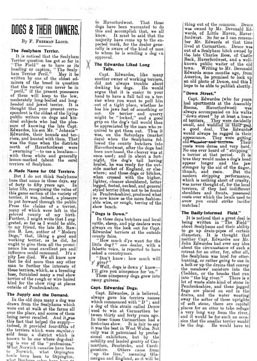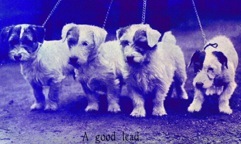Sealyham Century Site


Sealyham Century Site



“Dogs & Their Owners”
by F.Freeman Lloyd
about Captain Edwardes and his dogs.
Dogs & Their Owners
By
F.Freeman Lloyd

The Sealyham Terrier.
It is noticed that the Sealyham Terrier question has got so far in “The Field” as to have as its heading or caption, “The Sealyham Terrier Peril.” May it be written by one of the oldest admirers of the breed in question that the variety can never be in “peril,” if the present possessors of them will keep to the low, moderately long - bodied and long-headed and jawed terrier. It is thought that your present correspondent is the oldest of the living public writers on dogs and kindred subjects who had the pleasure of knowing the late Capt. Edwardes, his son Mr.”Johnnie” Edwardes, their hounds and terriers, and hunted with them.
That was the time when the districts north of Haverfordwest were “swarming” - to use a localism - with these white and generally lemon-marked (about the ears) terriers of Sealyham.
A Made Name for Old Terriers.
But I do not think Sealyhams bore that name in those days, say of forty to fifty years ago. In later life, recognising the the value of this game section of the variety of terrier, it was, indeed, a pleasure to put forward through the public Press the claims of a terrier, many of which were left in the beloved county of my birth. Further, I might write that I suggested, so far as I would be able. to my friend, the late Mr. Rawdon B.Lee, author of “Modern Dogs,” that liking a good and working terrier, as he did, he ought to give them all the prominence his most excellent pen and influence could command. It´s a pity Lee died. We all know now that he did more than any other man to further the interests of these terriers, which, as breeding base, furnished many real show terrier of the rough or wire-haired kind for the show ring at places outside of Pembrokeshire.
The Supply and the Demand.
In the old days many a dog was drawn from the Sealyhams which were out at walk at the farms all over the place, and scores of them being never recalled. And it was this fact that helped the supply indeed, it provided four -fifths of the terriers which were regularly sold from a district which is known to be one where dog-dealing is one of the “professions.”
What Norwich canaries have been to Norwich, what Orpington fowls have been to Orpington, what Banbury cakes have been to Banbury the Sealyham has been to Haverfordwest. That these dogs have been warranted to do this and accomplish that , we all know. It must be said that the majority have come up to the expected mark, for the dealer generally is aware of the kind of man to whom he is sending a dog on approval.
The Edwardes Liked Long Tails.
Captain Edwardes, like many another owner of working terriers, did not always trouble about docking his dogs. He would argue that it is easier to your hand to have a full tail on a terrier when you want to pull him out of a tight place, whether he has his jaws fast of something or not. Or terrier and quarry might be “locked,” and a good grip on the dog´s tail would then be appreciated by the man who required to get them out. Thus it was, on the Saturdays (market days) when the Sealyhams followed the county butchers into Haverfordwest, after the dogs had been purchased , the cleaver was at once used; and in about a fortnight, the dog´s tail having healed, he was ready for the outside market of England, or elsewhere; and these dogs or bitches, when crossed with the higher, lighter, cleaner shouldered, better legged, footed, necked and general styled terrier (then not to be found in Pembrokeshire), produced what we now know as the more fashionable wire, or rough, terrier of the show bench.
“Dogs is Down.”
In those days butchers and local cattle, sheep and dog dealers were always on the look out for Captain Edwardes´terriers at the outside county fairs.
“How much d ´ye want for the little dog?” one dealer, with a falsetto voice, is reported to have asked a countryman. “Don´t know: how much will y´give?” “Well, dogs is down y´know. I´ll give you nine pence for´ en.”
These nine penny dogs grew into many guineas.
Captain Edwardes´ Dogs.
Capt.Edwardes, it is believed, always gave his terriers names which commenced with “D”; and a dog of this strain called Deuce used to win at Carmarthen between thirty and forty years ago. In those times Carmarthen had a first-class show. It is fair to say it was the best in West Wales. Not only was it patronised by professional exhibitors, but by the nobility and landed gentry of Carmarthen, Pembroke, and Cardiganshire. Others came from “up the line,” meaning Glamorgan and England, so it will be..(this line is unreadable on the original).........
..thing out of the common. Deuce was owned by Mr. Devonald Edwards, of Little Haven, Haverfordwest. So far as I can remember Mr Edwards at that time lived at Carmarthen. Deuce was out of a Sealyham bitch owned by the late Charles Rees, of Castle Back, Haverfordwest, and a well known public waiter of the old town. Writing to Mr. Devonald Edwards some months ago, from America , he promised to look up an old photo of Deuce, and this I hope to be able to publish shortly.
Down Street.
Capt.Edwardes (who for years had apartments at the Assembly Rooms, Haverfordwest,) was always accompanied on his walks “down street” by at least a brace of terriers. They were decidedly small, and waddled in their gait a good deal. The Edwardes would always be ragged in their appearance. The were getting old, master and terriers. Their coats were dense and very hard. No one ever heard of “stripping” a terrier at that period. It is true they would make a dog´s head appear longer and the jaw stronger by the aid of the finger, thumb and resin. But the modern stripping performance, which is nothing short of cruelty, was never thought of, for the local terriers, if they had indifferent shoulders and fronts, possessed coats over which the locals used to avow you could strike lucifer matches!
The Badly-Informed Field.
It is noticed that a great deal is being written in “The Field” about Sealyhams and their ability to go up drain-pipes of certain diameters. It is thought that neither Capt.Edwardes nor Mr .John Edwardes had ever any idea about the circumstance of such a retreat for an otter, for, after all, the Sealyham was bred for otter-hunting, or rather going to one in a holt or up the drains that convey the meadows moisture into the Cledddan, or the brooks that run into “the big river.” There is a lot of waste slate-king of stone in Pembrokeshire, and these jagged flags are placed on end in the drains, and the water wearing away the softer of these uprights of soft stone, there are capital places for an otter to take refuge a very long way from the river, and it would be for such an occasion that the smaller terrier would be the dog. He would have to squeeze himself through - go wherever a bitch otter could go - and generally, if not always, with his belly in the water or mud. That was the kind of drain the Sealyham terrier was originally bred for - the local conditions demanded such a dog.
Simply a Terrier.
Although the Sealyham was primarily bred for the purposes of going to otter, no one can deny that he will not face anything. Indeed , as we know , the otter is among the toughest of the tough. But how many opportunities has the ordinary man to try his terrier with an otter? That is only given to those who reside in those districts where there are otters. As to the Sealyham going to fox, or badger, killing a polecat, a brook-side ratter, a useful terrier with ferrets, it is not for one to say whether he as as good, better or worse than any other terrier. Improve his forelegs and shoulders (without getting him stilty) and he will be found to fill the bill in every way.

